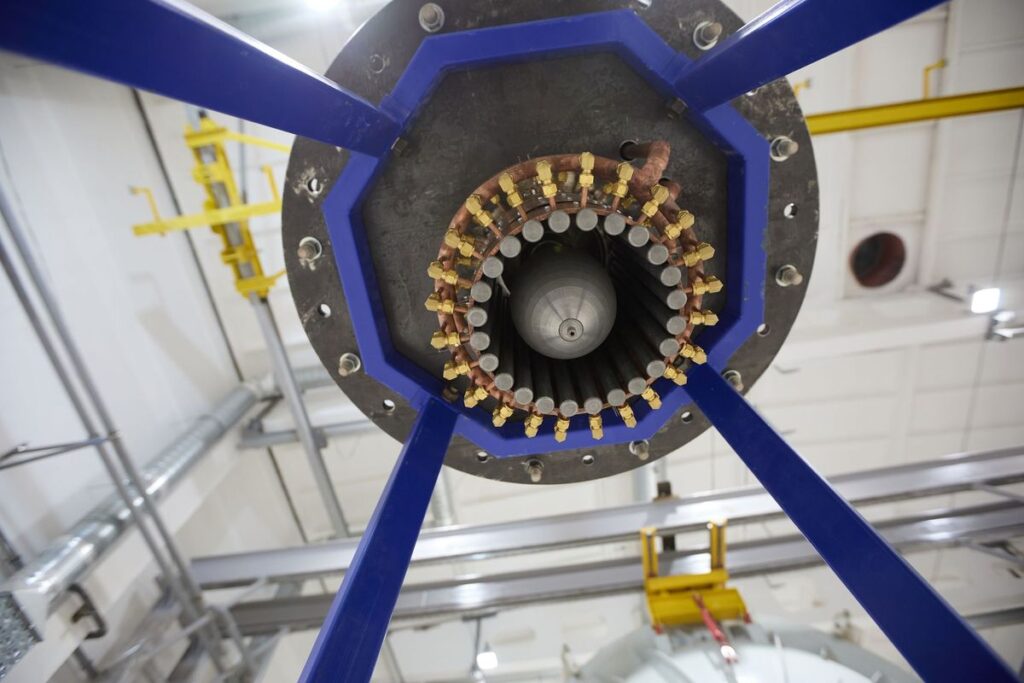“It not only demonstrates the engine’s potential for future ‘nuclear tugs’ in space but also paves the way for reducing the cost of their production.”
— Alexey Voronov, First Deputy Director General for Science at Rosatom’s Research Institute.
By Abdulrahman Aliagan, Abuja, Nigeria
In a groundbreaking leap towards revolutionizing space exploration, scientists at Rosatom, Russia’s state nuclear energy corporation, have successfully developed a laboratory prototype of a plasma electric rocket engine. With its exceptional thrust performance and unprecedented fuel efficiency, this innovative engine could significantly reduce the time it takes to travel to distant planets, marking a new era in human space travel.
The journey to this remarkable achievement began as part of a broader initiative under Russia’s national technological leadership program, “New Nuclear and Energy Technologies,” launched in 2025. This program aims to harness the power of nuclear science and engineering to drive advancements in space exploration, energy solutions, and more.
This is contained in a statement made available to time Nigeria, signed by Lada Terentyeva, Rosatom Africa PR Support via: pr_support@acppro.ru.
According to the release, “At present, a one-way travel to Mars onboard spacecraft with conventional engines can take almost a year. Plasma engines could reduce the duration of flights to just 30 to 60 days, making return missions to Mars possible,” said Alexey Voronov, First Deputy Director General for Science at Rosatom’s Research Institute in Troitsk.
At the heart of this endeavor is the plasma electric rocket engine, a product of years of research and experimentation at Rosatom’s Research Institute in Troitsk. Unlike conventional chemical rocket engines, which rely on combustion to generate thrust, the plasma engine employs a magnetic plasma accelerator to propel spacecraft. This innovative approach not only enhances thrust—delivering at least 6 Newtons—but also achieves a specific impulse of at least 100 kilometers per second, far surpassing the capabilities of traditional engines.
Operating in a pulsed-periodic mode, the plasma engine boasts an impressive power output of 300 kilowatts. One of its most remarkable features is its ability to reduce fuel consumption by tenfold, making long-distance space travel more efficient and economically viable.
The creation of the plasma rocket engine prototype represents years of dedicated effort by a team of scientists and engineers. The project began with extensive theoretical studies and simulations, which laid the foundation for the engine’s design. The researchers then faced the challenge of translating their concepts into reality, developing advanced materials and technologies to withstand the extreme conditions of space.
One of the key milestones in this journey was the construction of a large-scale experimental facility at the Troitsk site. This state-of-the-art facility, currently under development, is equipped with a 14-meter-long vacuum chamber, boasting a diameter of 4 meters. Designed to replicate the conditions of outer space, the chamber features advanced systems for high-efficiency vacuum pumping and heat removal. This facility will be instrumental in testing the plasma rocket engine prototype and other cutting-edge space technologies.
The potential applications of Rosatom’s plasma rocket engine are nothing short of revolutionary. With conventional engines, a one-way trip to Mars takes nearly a year, exposing astronauts to prolonged cosmic radiation and other risks. However, the plasma engine could reduce this travel time to just 30 to 60 days, making human missions to Mars safer and more feasible.
“Developing the prototype is a critical milestone,” said Alexey Voronov, First Deputy Director General for Science at Rosatom’s Research Institute. “It not only demonstrates the engine’s potential for future ‘nuclear tugs’ in space but also paves the way for reducing the cost of their production.”
This breakthrough aligns with global efforts to make space exploration more accessible and sustainable. By combining nuclear and plasma technologies, Rosatom is poised to address some of the most pressing challenges in deep-space travel, from reducing costs to ensuring the safety of astronauts.
The development of the plasma rocket engine is more than just a technological achievement; it is a testament to the power of human ingenuity and perseverance. It symbolizes the beginning of a new era where interplanetary travel is not only faster but also more efficient and safer.
As Rosatom continues to push the boundaries of what is possible, the world watches with anticipation. The prospect of faster, more economical journeys to Mars and beyond brings humanity one step closer to realizing its dream of exploring the cosmos—a dream that now seems more attainable than ever.
This milestone is not just about reaching new destinations in space; it’s about redefining the way we think about travel, science, and the future of humanity. Rosatom’s plasma rocket engine stands as a beacon of hope and innovation, guiding us toward the stars.
Aliagan, is the Managing Editor, Time Nigeria Magazine and National President of Nigerian Guild of Investigative Journalists writes from Abuja.

